
endangered

Santa Lucia fir (Abies bracteata), from Cyclopedia of American Horticulture, 1909.
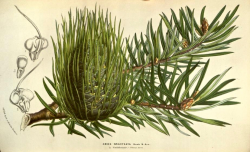
Santa Lucia fir (Abies bracteata), from Flore des Serres et des Jardins de l'Europe, Vol. 9, 1854–55.
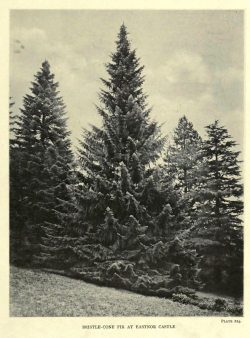
Santa Lucia fir (Abies bracteata), horticultural specimen from Eastnor Castle, from The Trees of Great Britain and Ireland, Vol. 4., 1909.
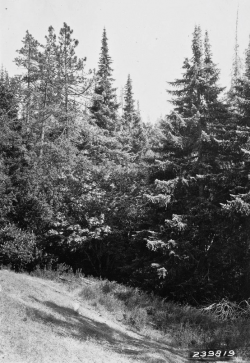
Santa Lucia fir (Abies bracteata), A. E. Wieslander Vegetation survey photo, Jamesburg Quad, July 24, 1929. Copyright © 2005 The Regents of the University of California.
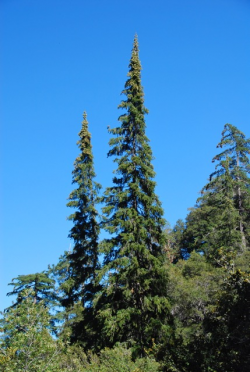
Santa Lucia fir (Abies bracteata). Cone Peak, Ventana Wilderness, Los Padres National Forest, Monterey County, CA. Copyright © Jeff Bisbee.
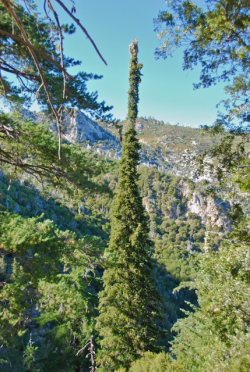
Santa Lucia fir (Abies bracteata). Cone Peak, Ventana Wilderness, Los Padres National Forest, Monterey County, CA. Copyright © Jeff Bisbee.
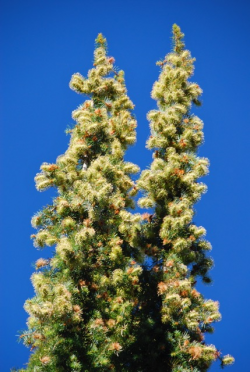
Santa Lucia fir (Abies bracteata). Cone Peak, Ventana Wilderness, Los Padres National Forest, Monterey County, CA. Copyright © Jeff Bisbee.

Santa Lucia fir (Abies bracteata). Cone Peak, Ventana Wilderness, Los Padres National Forest, Monterey County, CA. Copyright © Jeff Bisbee.
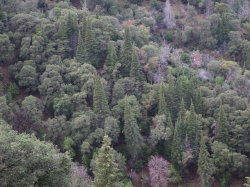
Santa Lucia fir (Abies bracteata). Miller Creek Canyon, Ventana Wilderness, Los Padres National Forest, Monterey County, CA. Copyright © Leor Pantilat.
PANTILAT2.png)
Santa Lucia fir (Abies bracteata). Miller Creek Canyon, Ventana Wilderness, Los Padres National Forest, Monterey County, CA. Copyright © Leor Pantilat.
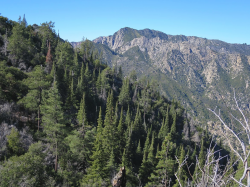
Santa Lucia fir (Abies bracteata). Ventana Cone area, Ventana Wilderness, Los Padres National Forest, Monterey County, CA. Copyright © Leor Pantilat.
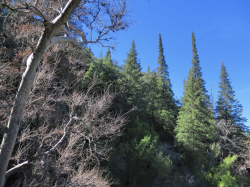
Santa Lucia fir (Abies bracteata). Villa Creek, Los Padres National Forest, Monterey County, CA. Copyright © Leor Pantilat.
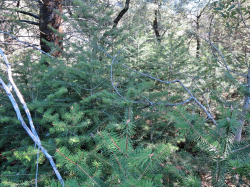
Santa Lucia fir (Abies bracteata) saplings. Villa Creek, Los Padres National Forest, Monterey County, CA. Copyright © Leor Pantilat.
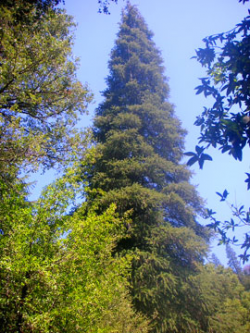
Santa Lucia fir (Abies bracteata), registered as a California Big Tree. 127 ft high. Los Padres National Forest, Monterey County, CA.



This fact sheet was prepared by Dylan M. Neubauer under award NA04N0S4200074 from the National Oceanic and Atmospheric Administration (NOAA), U.S. Department of Commerce (DOC). The statements, findings, conclusions, and recommendations are those of the authors and do not necessarily reflect the views of the NOAA or the DOC.
© Copyright 2006, Elkhorn Slough Coastal Training Program
Last updated: Sep 23, 2024 09:50
Common Names - Santa Lucia fir, bristlecone fir
Family - Pinaceae (Pine Family)
State Status - none
Federal Status - none
Habitat and Associates
Discontinuous stands of one to hundreds of trees, generally comprising < 5 ha, in less fireprone areas such as steep, west-, north-, or east-facing slopes in canyons or ravines, often in moist microsites near the bottom or at the head of drainages, often in talus or scree; above 1400 m on all exposures on rocky ridgetops, bluffs, or cliffs; and occasionally on stream benches or terraces. Generally in rocky, clayey, or loamy soil, occasionally on sandstone and serpentine (Talley 1974, CNDDB 2017, CNPS 2016 & 2017).
Closed-canopy stands with the shrub layer open to intermittent and a sparse herb layer occur most often within montane or lower montane hardwood–conifer forest; frequently associated with Quercus chrysolepis, Pinus coulteri, or Pinus lambertiana (Junipero Serra Peak and Cone Peak). Occasionally in chaparral (especially young trees) or riparian woodland, and, rarely, at lower elevations just upslope from redwood forest (Talley 1974). Other associates include Alnus rhombifolia, Acer macrophyllum, Arbutus menziesii, Calocedrus decurrens, Notholithocarpus densiflorus var. densiflorus, Pinus ponderosa var. pacifica, Quercus agrifolia var. agrifolia, Quercus parvula var. shrevei, and Umbellularia californica, (CNDDB 2017, CNPS 2017); Pinus sabiniana is an associate in one of the southermost stands (Hoover 1970). Elevation 183–1555 m (generally > 500 m; with more than half of distribution > 1000 m) (Talley 1974, Farjon 2010).
An Abies bracteata Forest Alliance is described in the Manual for California Vegetation Online (CNPS 2017) in areas where the fir has > 30% relative cover when co-dominant with Quercus chrysolepis. Two associations are included within this alliance (A. b./Galium clementis and A. b./Polystichum munitum) (Talley 1974, CNPS 2017).
Key Characteristics
Densely branched, pyramidally shaped evergreen tree, generally 10–40 m tall, occasionally to 50+ m, < 1.3 m wide, crown becoming very narrow and spire-like with age, easily recognizable from a distance; bark light red-brown, thin, smooth when young, becoming gray, slightly fissured, and scale-like with age, not fire-resistant; branches often drooping with age, the lower reaching or nearly reaching the ground; vegetative buds extremely large, 1–2.5 cm long, spindle-shaped, apices sharply pointed, non-resinous; twigs glabrous, glaucous when young, turning purplish-green or brown. Leaves < 6 cm long, stiff, flat, dark green and shiny adaxially, with faint groove or not, apices spinelike, stomata absent, silvery stomata in two bands abaxially. Pollen cones ca. 3 cm long, yellowish-green to brown; seed cones < 10 cm long, ovoid, becoming resinous, upward pointing, borne on upper third of crown, reddish-green aging to a pale purplish-brown, stalks < 15 mm long, stout, bracts exserted 1.5–4.5 cm beyond scales, apices with slender spines; seeds reddish-brown, broadly winged (Hunt 1993, Haller et al. 2017).
Differs from other Abies spp. in its “fusiform and resin-less buds, almost globular female cones with unusually long and needle-like bract cusps, and sharp-pointed dark green needles” (Xiang et al. 2009). Reaches at least 200 years in age (Ledig et al. 2006). The champion tree is 39 m tall, with an 11 m canopy and girth of 381 cm (California Big Trees 2016; see photo).
Flowering Period
Generally, pollen is shed from staminate cones starting in early May. Fruit ripens in late August, and seeds disperse September to October (USDA 2008).
Reference Population
Cone Peak, Ventana Wilderness, Los Padres National Forest (Monterey County)
Global Distribution
Santa Lucia fir is endemic to the Santa Lucia Range of the northern outer South Coast Ranges of California, in western Monterey and northwestern San Luis Obispo counties. It is narrowly distributed in a ca. 60-mile-long, northwest–southeast-running band, within ca. 13 miles of the coast, from the headwaters of the Carmel and Little Sur rivers in the north, inland to the headwaters of Arroyo Seco, and south to the headwaters of Arroyo de la Cruz (and, historically, perhaps upper Las Tablas Creek near Cypress Mountain) (1). The vast majority of trees occur in the northern half of the range, within the boundaries of the Ventana Wilderness in the Los Padres National Forest. The total area occupied by mature Santa Lucia fir stands is estimated at 30 km2 (Talley 1974).
Discovery and Taxonomy
Opinions differ as to who made the first scientific collection of the Santa Lucia fir: David Douglas or Thomas Coulter. It so happened that both naturalists obtained specimens within several months of each other—or possibly together—but both subsequently lost the field notes detailing their collections. In addition, Douglas died soon afterward. Therefore, the information relating to these collections is located in journal extracts, letters, articles, and the collections themselves—and these have been variously interpreted.
By chance, the two men found themselves together in Monterey during 1831 and 1832. Douglas had arrived in late December 1830, making several “excursions in [the] neighbourhood, until the end of April [1831],” when he “undertook a journey southward” to Santa Barbara (Hooker 1836). Richard G. Beidleman, in California’s Frontier Naturalists (2006), writes that it was during this trip that Douglas spent a “delightful week in the Santa Lucia foothills at the Franciscan Mission San Antonio de Padua,” hosted by Friar Cabot (2). Beidleman, echoing Willis L. Jepson (1910), speculates that Cabot “likely told Douglas that the special incense aroma permeating the mission buildings was pitch from a unique conifer—Incensio—collected from high in the surrounding mountains.” This, of course, was the Santa Lucia fir. Despite the plausibility of Douglas being informed of the tree’s existence and whereabouts during his visit, he did not make a collection at this time (Hooker 1836).
Around the “beginning of October 1831,” Thomas Coulter arrived in Monterey from Mexico, and “on October 18th” undertook “a quick trip south ... to Mission San Gabriel ... to plan for a trip to the Colorado River” the following spring (Beidleman 2006). As Coulter returned to Monterey on November 23, David Rogers, in his Flora of Tassajara (unpublished), speculates that it is “chronologically possible that he collected specimens of Abies bracteata and Pinus coulteri” during this trip, in the vicinity of Cone Peak.
Beidleman is more definite, stating that it is “likely that on this excursion [Coulter] took a side trip into the Santa Lucia Mountains to Mission San Antonio. Near there he collected specimens but no seeds of the beautiful Bristlecone Fir and the Coulter Pine, probably at Cone Peak.” In keeping with David Don, who first described the species (see below), several authors, including Charles S. Sargent (1898) and Jepson (1910), affirmed that the Santa Lucia fir was “first discovered” by Coulter in 1831, though Coulter’s biographers (Nelson and Probert), writing in 1994, claim that Douglas holds that distinction.
Upon Coulter’s return to Monterey, he encountered Douglas, who had returned in late August 1831 (Harvey 1947). In a letter to his mentor, William J. Hooker, dated November 23, 1831, Douglas wrote: “Since I began this letter, Dr. Coulter … has arrived here, with the intention of taking all he can find to De Candolle at Geneva” (Hooker 1836). He went on: “I do assure you, from my heart, it is a terrible pleasure to me thus to meet a really good man, and one with whom I can talk of plants.” Rogers relates that Douglas (and perhaps Coulter) lodged at the house of William Hartnell, an English merchant, and both men were “enlisted in the Compania Extranjera (Company of Foreigners),” under Hartnell’s leadership.
In late March 1832, Douglas made a trip into the Santa Lucia Range from the east, via Mission San Antonio, and “at last saw an Incensio, the Bristlecone Fir,” (Beidleman 2006) on Twin Peak, just north of Cone Peak (Jepson 1910). Beidleman notes that Douglas also saw sugar pine and Coulter pine during this trip and, a few sentences later, says that “Douglas collected the type specimen of the fir, and Coulter the type specimen of the pine, but at the time neither collected the seeds.” It is not clear whether Beidleman is implying that Douglas and Coulter were together on this particular journey, or that they made their collections separately. Nor is it clear how his reference to Douglas’s collection of the type specimen of the fir relates to Coulter’s earlier collection, and to current nomenclature (see below).
Rogers also suggests that Coulter may have accompanied Douglas on this trip, as Coulter was journeying to southern California and Arizona at this time (he left Monterey on March 20 and reached Santa Barbara on April 6).(3) Rogers states that, “[b]ased on what is known about their explorations in California, [his] hunch is that Coulter and Douglas were together when they encountered Abies bracteata in March of 1832, and that Coulter revisted the location in the following July [on his return trip to Monterey] in order to collect cones.” (Coulter left Santa Barbara July 7 or 8 and returned to Monterey on July 18 or 19 [Coville 1895]).
Douglas departed for Hawaii in August 1832 and from there shipped his collections, including the fir, to England (Hooker 1836). He described it in a letter to Hooker (1836) dated October 23, 1832 as “another new Pinus … (P. venusta), which I discovered [my italics] last March [1832], on the high mountains of California”—adding, “you will begin to think that I manufacture Pines at my pleasure.” Interestingly, Douglas makes no mention of Coulter in his account.
In a subsequent letter to Hooker, dated April 9, 1833, Douglas urged him to “include the Pines discovered in my late journeys, viz. Pinus venusta [= Abies bracteata], Sabini, and grandis” in Hooker’s Flora Boreali-Americana (Hooker 1836). Tragically, Douglas died two years later in Hawaii on July 12, 1834 (under mysterious circumstances), the year that Coulter returned to Europe (Beidleman 2006, Rogers 2016).
Inextricably intertwined with the confusion regarding the discovery of the Santa Lucia fir is the confusing history of its nomenclature. Based on Coulter’s collections, the first description of Pinus [= Abies] bracteata was published in 1836 (“sometime between June 9 and July 9” [Dayton 1952]) by David Don—along with four other “new species of the genus Pinus, discovered by Dr. Coulter in California.” This description appeared in both the 1836 edition of the Transactions of the Linnaean Society of London and in Aylmer B. Lambert’s 1837 edition of A Description of the Genus Pinus, Vol. 3. Confusion regarding the earliest date of publication, both in terms of the year (it was long thought to be 1837) and the month, lasted until William A. Dayton finally resolved the issue in 1952 (also see Little 1944 and 1949, Keck 1946).
Don wrote: “This curious and interesting species of Fir was discovered by Dr. Coulter on the sea side of the mountain range of Santa Lucia, about 1000 feet lower down than [Pinus] Coulteri.” Though Don does not mention the year or month of this discovery, he does include a description of the cone. Since this is the earliest published name, according to the rules of botanical nomenclature the specific epithet “bracteata” takes priority.
In December of 1836, Hooker posthumously published Douglas’s description of Pinus [= Abies] venusta from his 1832 letter. Despite this, Hooker and Arnott used the name Pinus bracteata in their 1841 Botany of Captain Beechey’s Voyage, citing Don’s description and John C. Loudon’s 1838 combination Picea bracteata.
In 1849, the combination Abies bracteata was published by Thomas Nuttall and became well established. Nuttall described the “curious and interesting fir” that “was, it seems, discovered by Douglas,” though described from specimens aquired by Coulter. Abies bracteata was cited in numerous publications until Charles S. Sargent (1889, 1898) popularized Abies venusta, a combination originally published in 1873 by Karl Koch. This name held sway until the middle of the 20th century (see Sudworth 1908, Jepson 1909, 1910 & 1925, Abrams 1923). In 1889, Sargent stated: “David Douglas, who discovered this species, first described it, calling it Pinus venusta. His name was published in 1836 ... a year earlier than Don’s Pinus bracteata ... so that the name should now become Abies venusta.” However, by 1898, in his Sylva of North America, Sargent (citing Hooker [1845]) had changed his mind, stating: “Abies venusta was discovered by Dr. Thomas Coulter in 1831.”
Simultaneously, Professor Carl Hansen, in his “Pinetum Danicum” (1898) believed, in error, that Douglas made his collection in March of 1831 (not 1832) and was thus the “discoverer.” Hansen relates: “This matchless Fir is another of those trophies that rewarded the laborious explorations and keen scrutiny of … David Douglas, who discovered this tree in March 1831. ... In the numerous published descriptions of this lovely Fir, another pioneer explorer is always connected with its discovery—to wit, Dr. Thomas Coulter.” Regarding the description, Hansen wrote: “David Don ... not only ignored Douglas’s name of Pinus venusta, published a year previously, but gave the credit of discovery to Dr. Coulter.” Adolphus H. Kent, in Veitch’s Manual of the Coniferae (1900) agreed: “This Fir was first described by David Don ... from herbarium specimens gathered by Dr. Thomas Coulter, to whom he wrongly assigned the merit of being the discoverer of the tree, a statement unfortunately accepted by most subsequent authors.”
In 1944, Elbert L. Little determined that Don’s description was first published in 1836 not 1837, though the month was still unknown, and until such time as the date could be resolved, he recommended retaining Abies venusta. In contrast, David D. Keck, writing in 1946, asserted that the “Santa Lucia Fir ... must again take the name by which it commonly went prior to 1889 ... Abies bracteata (D. Don) Nutt.” It was not until 1952 that the actual publication date (June or July of 1836) of Pinus bracteata was nailed down by William A. Dayton, leaving him to conclude that Abies bracteata (D. Don) Nutt. took precedence. But that was not the end of the story. The currently accepted name is Abies bracteata (D. Don) A. Poit., due to the fact that Antoine Poiteau published the name in 1845, thus preceding Nuttall’s 1849 publication and rendering Nutall’s authorship superfluous (see Munz 1959, Hickman 1993, Haller et al. 2017).
NOTE 1. Based on a 1927 Chester Dudley collection from “Upper Las Tablas Creek” and a report by Willis L. Jepson (1910) that the tree occurred as far south as the “mountains near Cambria, an indefinitely reported locality given [to Jepson] by Capt. Olmstead” (Rogers 2016, CNDDB 2017). The existence of trees in this location has not been confirmed.
NOTE 2. In his account, David Rogers (unpublished) relates that Douglas arrived at Mission San Antonio on April 27, 1831, and “reached Mission San Miguel by May 1st”—a timeline that would reduce the length of his mission stay to less than the “week” alluded to by Beidleman.
NOTE 3. Coulter and Douglas appear to have departed Monterey at different times. Nelson (1988) states: “On 20 March 1832 [Coulter] left Monterey on his great journey through southern California—Douglas remained behind in the hope of getting a passage on a ship going to the Sandwich Islands (Hawaii).”
Cultivation
Neither Douglas nor Coulter was able to collect seed, and German naturalist Theodor Hartweg’s 1847 attempt was also stymied. “Having cut down some trees, I found to my regret that the cones were but half grown and had been frost-bitten” (1848). It was not until English plant collector William Lobb visited the Santa Lucias in 1850 that he was able “by great exertions” to acquire seeds, which were sent back to Exeter (Kent 1900). It is from this original (ca. 1853/1854) batch that the oldest trees in European gardens sprang, and the exotic fir was widely celebrated for its striking beauty. As Hooker (1845) remarked: “Perhaps the introduction of no Conifer … has excited a more lively interest in horticulture and arboriculture than that of the ... species with its porcupine fruits.” Professor Hansen (1892) raved: “Too much cannot be said in favour of this little-known tree ... [and] it is beyond doubt one of the handsomest of the many Conifers with which California has enriched our empire.” Kent (1900) and Elwes and Henry (1906), provide inventories of many remarkable specimens growing in Europe at the time. One tree from the original seed batch was planted out in 1865 at Eastnor Castle (see photo), Herefordshire, and was still extant in 1970, having reached 37 meters (Mitchell 1972).
Countless botanists and plant hunters have conducted pilgrimages to the fir groves to collect seeds and specimens, and the tree is popular in gardens and arboreta where it thrives in milder climatic areas (Farjon and Rushworth 1989). Two groves planted from seed collected at Cone Peak in 1938 exist at the Regional Parks Botanic Garden in Berkeley, CA (O’Brien 2015), and viable seed was collected from these trees following the 1977 Marble Cone Fire.
Evolutionary History and Ecology
Along with other “paleoendemic” conifers of the California Floristic Province, such as the giant sequoia, the Santa Lucia fir is a relict of a warmer time, when it—or its close relatives—were once more widespread in the western U.S. Now it is the not only the rarest fir but also the sole extant member of its section—Bracteata Engelm. emend Sarg. (= subgenus Pseudotorreya Franco, see Liu 1971) (Stebbins and Major 1966, Farjon & Rushworth 1989, Xiang et al. 2009).
It exhibits “high molecular and morphological divergence” from other Abies and, depending on the type of DNA used for analysis (nuclear or chloroplast), appears to be either sister to all other Abies (Xiang et al. 2009), or “sister to one of the two major clades of the genus” (Aguirre-Planter et al. 2012, Baldwin 2015). Recent phylogenetic analysis (Xiang et al 2009) “supports the hypothesis that A. bracteata is likely the earliest diverging lineage in the genus,” and the divergence time from its nearest known relative has been estimated at 73 ± 13 mya (Aguirre-Planter et al. 2012).
Fossil and pollen evidence shows that sect. Bracteata was “once widespread in the western United States” and occurred “in the Eocene and Oligocene of Colorado, the Oligocene of Oregon, and the Miocene of Oregon, Nevada, and Idaho” (Leopold & Zaborac-Reed 2014). In the central Rockies, when the climate was warmer and wetter, these trees occurred with other conifers that currently have ranges restricted to relatively mild-climatic areas on the west coast, including coast redwood and California nutmeg. In the Early Oligocene, extensive vulcanism, followed by a cooling and drying trend, followed by uplift of the Colorado Plateau, resulted in the lineage’s apparent disappearance from Colorado, though it continued in the Pacific Northwest and Nevada, where fossil remains from the Middle and Late Miocene are not uncommon (Axelrod 1976, Leopold & Zaborac-Reed 2014). For example, in 1976, David Axelrod described Abies scherii, a close relative of A. bracteata, from fossils collected from the Purple Mountain and Middlegate floras of western Nevada.
A warming trend peaked during the Middle Miocene, and conditions were thought to be similar to those in the Klamath Range today, with occasional summer rainfall. Late Miocene Nevada deposits show the fir “occupied an ecotone between broadleaved evergreen sclerophyll forest and mixed conifer forest” and was associated with a more diverse group of trees and shrubs trees than today (Axelrod 1976), though some of the species—including Arbutus menziesii, Notholithocarpus densiflorus var. densiflorus, and Quercus chrysolepis, among others—are still common associates (Axelrod 1976) .
After the Miocene, the range of sect. Bracteata shrunk southward as a summer-dry regime prevailed. Axelrod (1976) suggests that it “may have been eliminated from the Sierra Nevada, where it probably occurred during the Pliocene, by the high evaporation rate in summer which was inimical to seedling establishment. A second factor was increasing winter cold with accompanying snow and ice,” both of which are known to have a “disastrous effect” on the Santa Lucia fir, as Steven Talley witnessed in 1974 during a particularly severe winter storm.
Ultimately finding refuge in the Santa Lucia Range of coastal California, the firs endured major climatic swings as well as rapid uplift during the Pleistocene and were forced to retreat to cooler, high-elevation microsites on rocky slopes. Molecular evidence suggests that the species “was reduced to a single interbreeding population, at least once,” possibly “during the warmer, dryer, mid-Holocene and then expanded throughout its present range” (Ledig et al 2006).
The Santa Lucia fir is found in areas with a mean average temperature of ca. 48–57 degrees F that receive ca. 20–40+ inches of winter rain (Leopold & Zaborac-Reed 2014). The tree’s restriction to moist microclimates suggests a low water potential. In addition, its susceptibility to fire limits its distribution to areas where fuel does not accumulate, and possibly to areas where fire cannot enter a grove from below. The mostly bare soil in these areas provides an ideal substrate for germination (Talley 1974, Sullivan 1993). Cone production is variable, with abundant crops every 3–5 years. Seed longevity is short (< 2 years), and seeds are primarily dispersed by wind (Sullivan 1993), though gravity and animals such as birds and squirrels may play a role (USDA 2008, CNPS 2017).
The majority of viable seeds in a greenhouse study germinated “under a 5 degrees F. diurnal temperature range, and rates declined above 73.4 degrees” (Talley 1974, Sullivan 1993). Seed-treatment is not a requirement for germination (USDA 2008). Seedlings are not drought-tolerant but are shade tolerant (Talley 1974), and seedlings have been observed emerging from litter in dense shade (Hoover 1970).
Despite the negative effects of pests on reproduction and tree health, Talley, in his ecological study of the Santa Lucia fir, (1974) observed that the firs still had an “abundance of reproduction.”
Conservation and Threats
Santa Lucia fir is the rarest fir. Mishler (1995) has observed that not “all species are . . . equal in a phylogenetic sense,” promoting the idea that “conservation priorities can best be set by a consideration of the phylogenetic relationships among species.” Following this systematics-based approach, it is clear that the conservation of a species with more genetic differences between it and its closest relative (e.g., the Santa Lucia fir) “should carry a higher priority” than conservation of a species with relatively few differences (Mishler 1995).
The IUCN Red List (Thomas & Farjon 2013) classifies the species as “Near Threatened on the basis of its restricted distribution, a decline in the quality of the habitat in areas surrounding existing stands due to the effects of Sudden Oak Death, poor regeneration, and poor re-establishment potential. It is also potentially susceptible to indirect effects of climate change. Any further change in its status could lead to a listing as Endangered.”
Elaborating, Thomas and Farjon state that “variations in precipitation, [and] associated changes in fire frequencies and intensities would be problematic. The Santa Lucia fir’s ability to respond and adapt to changes in its environment is hampered by poor seed set associated with inbreeding and seed predation, infrequent regeneration, and a lack of genetic diversity within and between subpopulations” (also, see Ledig et al. 2006).
The Santa Lucia fir has a California Rare Plant Rank (CRPR) of 1B.3, which signifies it is rare throughout its range and meets the requirements for state listing; .3 meaning “not very endangered in California” (CNPS 2016a). The CNDDB Element Ranking (2017) assigns the taxon a global and state rating of G2G3/S2S3 (between imperiled and vulnerable).
The Abies bracteata Forest Alliance has a listing of G3/S3.2, meaning that it has 21–100 viable occurrences world/statewide and/or > 2,950–12,950 hectares (7290–32,000 acres) of occupied habitat; .2 meaning “threatened” (CNPS 2016b). Talley estimated 7,576 total acres of Santa Lucia fir forest (USDA 2005d) in 1974, and Olsen (1968) reported “at least four hundred mature trees in San Luis Obispo County.”
The California Natural Diversity Database (CNDDB) lists 82 occurrences of Santa Lucia fir (2017). Ca. 35 new occurrences were added for the 2017 update, primarily based on the Wieslander vegetation survey maps from the 1930s and from Griffin and Critchfield’s 1972 range map for the species. A rough estimate of population numbers documented in all occurrences totals ca. 10,000 trees. Ca. 30 occurrences have been observed since 2010, the majority of those during 2013–14, when the California Native Plant Society (CNPS) conducted rare plant treasure hunts in the Los Padres National Forest (CNDDB 2016). Surveys are needed to verify the existence/status of the remaining occurrences.
CNDDB (2017) lists 74 occurrences in the Monterey Ranger District of the Los Padres N.F, and Talley (1974) estimated that 95% of the total acreage occurs there. The tree is designated by the Forest Service as Sensitive, due to concerns regarding population viability. Management must ensure it does not become “threatened or endangered because of Forest Service actions,” and viable populations must be maintained (Bosch 2002). Sensitive plants are protected through Forest Plans along with the Biological Evaluation (BE) process, which evaluates the potential effects of Forest Service activities on these species.
More than ca. 90% of the trees within the Forest occur in the Ventana Wilderness, generally in remote areas, thereby receiving high levels of protection (Los Padres ForestWatch 2016). In addition, since June 1987, the 2,787-acre Cone Peak Gradient Research Natural Area (RNA) permanently protects Santa Lucia fir stands within its boundaries, allowing only nonmanipulative research and observation (Cheng 2004). Should it become established, a Candidate RNA in the Ventana Cones area would further protect 2,220 acres of Santa Lucia fir/canyon live oak forest (USDA 2005c).
A 2005 Forest Service Land Management Plan (USDA 2005a) stated that the Santa Lucia fir was “stable but at continuing risk due to its highly restricted natural range and its susceptibility to fire-kill”—giving it a threat category of “4,” meaning “uncommon, rare, or disjunct or peripheral in Plan area with no substantial threats from FS activities.” Regarding these activities, a 1999 Forest Service report (Stephenson & Calcarone) states that “[f]ire suppression activities such as fire lines and fuelbreaks are not currently allowed in stands . . . . Fire is not prevented from burning through stands nor is it directed toward stands." A 2003 vegetation management project was “designed to avoid direct fuels treatment in stands” while reducing fuels in adjacent stands (USDA 2005d).
Two occurrences on Fort Hunter-Liggett, owned by the U.S. Army, were last surveyed for in 1996–97. Threats include military training and increasing fire frequency (CNDDB 2017). A single occurrence at Ventana Camp on Pfeiffer-Big Sur State Park property was last surveyed for in 2017, and no trees were located (CNDDB 2017). A 1993 publication (Henson & Usner) stated that the stand was “not reproducing well” and was “gradually being replaced by tanoak.” This area burned in the 2014 Pfeiffer Fire, so any remaining trees may have perished (Frey, pers. comm. 2017). The ownership for six occurrences is unknown.
Of the three San Luis Obispo occurrences, the southernmost, based on a 1927 collection, has not been observed since. The other two, on private Hearst Ranch lands at the headwaters of Arroyo de la Cruz and San Carpoforo Creek, are extant, though require fieldwork. Anecdotal information conveyed from local botanist Doc Miller indicates that “the headwater stands all survived” the 2016 Chimney Fire (Chesnut pers. comm. 2016).
Fire. Located in a summer-dry Mediterranean ecosystem where periodic burning is the rule, catastrophic fire has long been considered a threat to the Santa Lucia fir, with its thin bark and canopy architecture (Talley 1974). During the pre–Euro-American settlement era (before 1850), periodic surface fires ignited by lightning and later by Native Americans ensured that fuel levels were kept low (Cooper 1961, Talley & Griffin 1980). A 2011 study determined the pre-settlement mean Fire Return Interval for Santa Lucia fir was 117 years (with a median of 93 years) (Van de Water & Safford).
Beginning in the 1890s, “tales of huge,” mostly human-caused fires in the Santa Lucias were “common,” and it is known they “burned large portions” of the area north of Cone Peak, where the majority of the Santa Lucia fir stands occur (Griffin 1978, Talley & Griffin 1980). After the Forest Service assumed management of the land in 1907, fires significantly declined in frequency and extent, dramatically increasing the fuel load (Griffin 1978). Since the 1970s, a series of large, mostly lightning-caused fires have occurred in the Santa Lucia Range (Buckeye 1970 [human-caused], Marble-Cone 1977, Rat Creek-Gorda 1985, Wild Cattle 1996, Kirk Complex 1999, and Basin Complex 2008), including the most recent—the Soberanes Fire of 2016—a human-caused conflagration that burned 132,127 acres in the northern part of the range from July through October (ca. 95,000 acres in the Monterey Ranger District, Los Padres National Forest) (Cal Fire 2016).
In 1974, Talley “determined that there were few differences between past and present fire intensities within stands, despite changing fire regimes in California.” Following the 1970 fire, Talley observed that entire slopes were burned, “while the two fir stands in the burn received only ground fires, or didn’t burn at all.” Following the 1977 fire, which burned 178,000 acres north of Cone Peak, Griffin (1978) noted that some firs on the edges of groves were killed by ground fire, but suspected “that insect damage may finally kill more firs than the fire” as was observed by Talley (1974) following the 1970 fire. Griffin (1978) summarized that “some firs were killed, some additional trees will die, but the species and even individual stands are in no way doomed.”
Though the 1985 fire burned “virtually the entire [Cone Peak Gradient] RNA,” (Keeler-Wolf 1990), the fir survived in this area, and as of 2013, numbered ca. 1000 trees (CNDDB 2017). Following the 2008 fire, CNPS surveys in 2013–14 on the Los Padres N.F. noted dead trees in stands occurring in burned areas, with the highest mortality in the Ventana Double Cone grove. Surveyors also noted some post-fire recruitment in two stands (CNDDB 2017).
Overall impacts from the Soberanes Fire have not yet been evaluated. Ca. 32 CNDDB (2017) occurrences lie within or near the fire’s perimeter, including the Miller Canyon occurrence with thousands of trees, the Ventana Double Cone occurrence with 1500+ trees, and the Church Creek and Pine Valley occurrences with 500+ trees each (CNDDB 2017). Anecdotal information regarding the Miller Canyon and Church Creek populations indicates that they are “generally OK, though they did sustain some mortality due to backfiring operations” (Splain, pers. comm. 2016). Leor Pantilat (pers. comm. 2017) reports that “it appears most of the Santa Lucia fir groves within the fire perimeter survived,” except for “a pretty grove near Ventana Knob.”
Other than this type of anecdotal evidence, the effects of the last half century of fires on Santa Lucia fir stands have not been studied systematically. To evaluate these impacts, CNPS (2016b) recommends that the “spatial turnover of stands” should be examined from “repeat aerial photography.” This is especially important as fire regimes change in response to climatic change and anthropogenic activities.
Sudden Oak Death. Fire effects vary widely over the landscape, depending on a myriad of factors. In addition to climate change, another significant trend is the increase in fuel levels in the Santa Lucia Range due to the presence of Sudden Oak Death (SOD). First observed in the range during the mid-1990s, the virulent pathogen (Phytophthora ramorum, an oomycete) has caused extensive mortality of tanoak, coast live-oak, and Shreve oak. A 2007 study estimated that ca. 200,000+ trees had succumbed to SOD, and that was still at a relatively early phase in the epidemic (Meentemeyer et al.).
Invasives. A more recent development that may influence fire behavior in Santa Lucia stands is the presence of the invasive French Broom (Genista monspessulana) in the understory. A shade-tolerant shrub, it can compete with fir seedlings (Stephenson & Calcarone 1999), and studies suggest that it “burns readily and carries fire to the tree canopy layer, increasing both the frequency and intensity of fires in invaded areas” (Zouhar 2005). Depending on fire-severity, it has the capacity to resprout from the root crown, and high germination rates from an existing soil seedbank are possible after “soil and vegetation disturbance such as that caused by fire” (Zouhar 2005). A 2005(d) USDA report recommended that the degree of threat posed by invasive French Broom should be studied, along with the “distribution, density, and age structure” of the stands, in order to determine whether these are changing over time.
Reproduction. Another threat to the Santa Lucia fir is low reproductive success. In their 2006 study, Ledig et al. (2006) found the “greatest number of sound seeds per cone” at Cone Peak in a large population where cross-pollination was more likely. They hypothesize that low seed numbers overall may be caused by inbreeding depression and selfing in smaller populations. The “real danger,” to the Santa Lucia fir, the authors assert, is the species’ lack of genetic diversity, which occurred “in the process of range reduction” after the Miocene, causing the fir to be less resilient to new threats in a changing environment.
Ledig et al. (2006) recommend that the tree’s “remaining genetic resources . . . be protected ex situ in seedbanks and field gene banks for the purposes of restoration or creation of new populations “if climate change scenarios unfold as projected.” Though collection from as many populations as possible would be ideal, their research found that the “maximum number of alleles and polymorphic loci were found in Cone Peak and to a lesser degree, Big Sur.”
Under an agreement with the Los Padres National Forest seed collection efforts for ex situ conservation have been undertaken by the Rancho Santa Ana Botanic Garden (RSABG) during 2014–15 and 2017. No viable seed was collected in 2014–15, and ca. 700 seeds of unknown viability were collected in 2017. 500 of these will be sent to the National Laboratory for Genetic Resource Preservation in Fort Collins, Colorado and the remainder will be propagated at RSABG, dependent on viability (Meyer, pers. comm. 2016, Fraga, pers. comm. 2017).
Other Pests and Pathogens. Seed loss due to insect herbivory can reach 100% in some years, therefore large cone crops are necessary to outpace rates of consumption (Talley 1974). Two insect species were described from 1880s cone collections: the fir seed chalcid (Megastigmus pinus), whose larvae have been known to destroy entire seed crops (Talley 1974), and the fir seed moth, Cydia (Laspeyresia) bracteatana, whose larvae bore through scales and consume seeds. Cediomyid fly (gall midges or gall gnats) larvae infest seeds (Comstock 1880, Keen 1953), as well as cone maggots (Hylemya/Earomyia spp.), which attack cones and seeds (USDA 2008).
Other pests include a “green larva (probably a moth) [that] severely defoliates the young shoots . . . and mature trees” (Talley 1974), and a bark beetle (Scolytus dentatus) described from a specimen collected on Cone Peak (Bright 1964) that attacks the trunk and larger limbs of the fir, which is its only host plant (Bright & Stark 1973). Two fungal rust diseases have also been documented: Lirula nervisequia var. conspicua and Lophodermium sp. (Scharpf et al. 1970, Popp & Lundquist 2006); and in 2016, Sims et al. report on the presence of branch and trunk cankers caused by Diplodia mutila on trees from two fir groves at the Regional Parks Botanic Garden in Berkeley, CA. Though the pathogen is known to affect angiosperms and gymnosperms, this is "the first report of D. mutila causing bristlecone fir branch canker--a significant disease of large branches and trunks of A. bracteata."
Climate Change. Further shrinking of habitat due to climatic change, combined with drought and increased fire frequency would have a negative effect on the already very rare Santa Lucia fir.
Other. Contractors have been known to cut trees during roadside brushing projects (CNDDB 2016). Fire-fighters have negatively impacted stands and individual trees during fire-fighting operations (Splain, pers. comm. 2016).
References
Abrams, L. 1923. Illustrated flora of the Pacific states., Vol. 1. Stanford University Press, Stanford, CA.
Axelrod, D. I. 1976. Evolution of the Santa Lucia fir (Abies bracteata) ecosystem. Annals of the Missouri Botanical Garden 63(1):24–41.
Bailey, L. H. and W. Miller 1909. Cyclopedia of American horticulture, 6th Ed., The Macmillan Co.
Baldwin, B. G. 2014. Origins of plant diversity in the California floristic province. Annual Review of Ecology, Evolution, and Systematics 45:347–69.
Beidleman, R. G. 2006. California’s Frontier Naturalists. UC Press, Berkeley and Los Angeles, CA.
Bickford, C. and P. Rich. 1984. Vegetation and flora of the Landels-Hill Big Creek Reserve. Publication No. 15, Environmental Field Program. University of California, Santa Cruz.
Bosch, M. 2002. Sensitive species – key policies and requirements. USDA, Forest Service.
Bright, D. E. 1964. Descriptions of three new species and new distribution records of California bark beetles (Coleoptera: Scolytidae). Pan-Pacific Entomology 40:165–170.
Bright, D. E., Jr. and R. W. Stark. 1973. The bark and ambrosia beetles of California (Coleoptera: Scolytidae and Platypodidae). Bulletin of the California Insect Survey 16.
Cal Fire. 2016. Incident Information: Soberanes Fire. http://cdfdata.fire.ca.gov/incidents/incidents_details_info?incident_id=1348 [acc. 9 Dec. 2016].
California Big Trees. 2016. Urban Forest Ecosystems Institute. http://californiabigtrees.calpoly.edu/tree-detail/abies-bracteata/387 [acc. 5 Dec. 2016].
Cheng, S., ed. 2004. Forest Service Research Natural Areas in California. PSW-GTR-188. USDA, Forest Service, Pacific Southwest Research Station, Albany, CA.
Chesnut, J. San Luis Obispo CNPS rare plant chairperson, personal communication, Dec 2016.
CNDDB (California Natural Diversity Database). 2017. California Department of Fish and Wildlife [7 Feb 2017]
CNPS (California Native Plant Society), Rare Plant Program. 2016. Abies bracteata. Inventory of Rare and Endangered Plants (online edition, v8-02). CNPS, Sacramento, CA http://www.rareplants.cnps.org/detail/66.html [acc. 11 Dec. 2016].
CNPS. 2017. A manual of California vegetation online. Abies bracteata Forest Alliance: Santa Lucia fir groves. http://vegetation.cnps.org/alliance/2 [acc. 20 Dec 2016].
Comstock, J. H. 1880. Report of the Entolomologist of the United States Department of Agriculture for the year 1879. Government Printing Office, Washington, DC.
Coville, F. V. 1895. The botanical explorations of Thomas Coulter in Mexico and California
Botanical Gazette 20(12):519–531.
Dayton, W. A. 1952. Some notes on United States tree names. Rhodora 54:67– 9.
Don. D. 1836 [1837 publ. 21 Jun–9 Jul 1836]. Descriptions of five new species of the genus Pinus, discovered by Dr. Coulter in California. Transactions of the Linnaean Society of London 17:443.
Dudley W. R. 1902. A notable California fir: Abies venusta Koch. Forestry and Irrigation 8: 193–198.
Earle, C. ed. 2014. The Gymnosperm Database: Abies bracteata. http://www.conifers.org/pi/Abies_bracteata.php [acc. 5 Dec 2016].
Eastwood, A. 1897. The coniferae of the Santa Lucia Mountains. Erythea 5:71–74.
Eastwood, A. 1939. Early botanical explorers on the Pacific Coast and the trees they found there. California Historical Society Quarterly 18(4):335–346.
Elwes, H. J. and A. Henry. 1909. The trees of Great Britain and Ireland, Vol. 4. Private printing, Edinburgh, UK.
Ewan, J. 1973. William Lobb, plant hunter for Veitch and messenger of the Big Tree. University of California Publications in Botany 67:1–36.
Ewan, J. 1995. Review: A Man Who Can Speak of Plants: Dr. Thomas Coulter (1793–1843) of Dundalk in Ireland, Mexico & Alta California, by E. C. Nelson and A. Probert. Taxon 44(2):289–290.
Farjon, A. J. 2010. A Handbook of the World’s Conifers, Vols. 1 & 2. Brill, Leiden, NL–Boston, MA.
Farjon, A. and K. D. Rushforth. 1989. A classification of Abies Miller (Pinaceae). Notes of the Royal Botanic Garden, Edinburgh 46:59–77.
Fraga, N. 2017. Rancho Santa Ana Botanic Garden, Director of Conservation Programs, personal communication, 3 Nov 2017.
Frey, J. State Parks Resource Ecologist, personal communication, 23 Jan 2017.
Furniss, R. L. and V. M. Carolin. 1977. Western forest insects, Misc. Pub. No. 1339. Pacific Northwest Forest and Range Experiment Station, USDA, U.S. Government Printing Office, Washington, DC.
Gibson, H. H. and H. Maxwell, ed. 1913. American Forest Trees. Hardwood Record, Chicago, IL.
Greenlee, J. M. and J. H. Langenheim. 1990. Historic fire regimes and their relation to vegetation patterns in the Monterey Bay area of California. American Midland Naturalist 124(2):239–253.
Griffin, J. R. 1978. The Marble-Cone fire ten months later. Fremontia 6(2):8–14.
Griffin, J. R. 1975. Plants of the highest Santa Lucia and Diablo Range peaks, California, PSW-110. USDA, Forest Service, Pacific Southwest Forest and Range Experimental Station, Berkeley, CA.
Griffin, J. R. and W. B. Critchfield. 1972. Distribution of forest trees in California, PSW-82. USDA, Forest Service, Pacific Southwest Forest and Range Experimental Station, Berkeley, CA.
Haller, J. R., N. J. Vivrette, and J. R. Griffin. 2017. Abies bracteata, in Jepson Flora Project (eds.) Jepson eFlora, http://ucjeps.berkeley.edu/cgi-bin/get_IJM.pl?tid=11522 [acc. 18 November 2016].
Hansen, C. 1892. Pinetum Danicum. Journal of the Royal Horticultural Society 14:257–480.
Hartweg, T. 1848. Journal of a mission to California in search of plants, IV. Journal of the Horticultural Society of London 3:217–227.
Harvey, A. G. 1947. Douglas of the Fir. Harvard University Press, Cambridge, MA.
Henson, P. and D. J. Usner. 1993. The natural history of Big Sur. University of California Press, Berkeley, CA.
Herz-Smith, S. 1988. The Veitch nurseries of Killerton and Exeter c. 1780–1863: Part II. Garden History 16(2):174–188.
Hickman, J. C., ed. 1993. The Jepson Manual: Higher Plants of California. University of California Press, Berkeley, CA.
Hooker, W. J. 1836. A brief memoir of the life of Mr. David Douglas with extracts from his letters. Companion to the Botanical Magazine 2:79–182.
Hooker, W. J. 1853. Curtis’s Botanical Magazine 79, Tab. 4740.
Hooker, W. J. and G.A.W. Arnott. 1841. The Botany of Captain Beechey’s voyage, California—Supplement. London: n.p. 2:394.
Hoover, R. F. 1970. The Vascular Plants of San Luis Obispo County, California. University of California Press, Berkeley, CA.
Howitt, B. F. and J. T. Howell. 1964. The vascular plants of Monterey County, California. Wasmann Journal of Biology 22:1–184.
Hunt. R. S. 1993. Abies. In: Flora of North America Editorial Committee, eds. 1993+. Flora of North America North of Mexico. 19+ vols. New York and Oxford. Vol. 2. http://www.efloras.org/florataxon.aspx?flora_id=1&taxon_id=250100422 [acc. 18 November 2016].
IUCN Red List of Threatened Species. 2016. Abies bracteata. http://www.iucnredlist.org/details/34019/0 [acc. 8 Dec. 2016].
Jepson, W. L. 1909. A flora of California, vol. 1. Cunningham, Curtiss, and Welch, San Francisco, CA.
Jepson, W. L. 1910. The Silva of California. The University Press, Berkeley, CA.
Jepson, W. L. 1925. Manual of the flowering plants of California. University of California Press: Berkeley & Los Angeles, CA.
Jepson Interchange. Abies bracteata (D. Don) A. Poit. http://ucjeps.berkeley.edu/cgi-bin/get_cpn.pl?11522&expand=1 [acc. 5 Dec. 2016]
Keck, D. D. 1946. Bibliographic notes on Abies bracteata and Pinus coulteri. Madroño 8:177–208.
Keen, F. P. 1958. Cone and seed insects of western forest trees. Technical Bulletin No. 1169. U.S. Department of Agriculture, Washington, DC.
Keeler-Wolf, T. 1990. Ecological surveys of Forest Service Research Natural Areas in California, PSW-GTR-125, USDA, Forest Service, Pacific Southwest Research Station, Berkeley, CA.
Kent, A. H. 1900. Manual of the Coniferae, 497, note. James Veitch & Sons, London, UK.
Koch, K.H.E. 1873. Dendrologie 2(2):210.
Lambert, A. Y. 1836. A description of the Genus Pinus, ed. 3 (in 5 editions from 180– 1842).
Lanner, R. 1999. Conifers of California. Cachuma Press, Los Olivos, CA.
Ledig, F. T. 1988. Genetic structure and the conservation of California’s endemic and near-endemic conifers. Pp. 587–594 in T. S. Ellis, ed., Conservation and Management of Rare and Endangered Plants. CNPS, Sacramento, CA.
Ledig, F. T., P. D. Hodgskiss, and D. R. Johnson. 2006. Genetic diversity and seed production in Santa Lucia fir (Abies bracteata), a relict of the Miocene Broadleaved Evergreen Forest. Conservation Genetics 7:383–398.
Legg, K. 1953. Bristle-cone fir makes its last stand. Nature Magazine 46:521–522.
Leopold, E. B. and S. Zaborac-Reed. 2014. Biogeographic history of Abies bracteata (D. Don) Poit. in the Western United States, in Paleobotany and biogeography, Chapter 9. Monographs in Systematic Botany 128:252–286. [acc. 7 Dec 2016]
Munz, P. A. 1959. A California flora. University of California Press, Berkeley & Los Angeles, CA.
Little, E. L., Jr. 1944. Notes on nomenclature in Pinaceae. American Journal of Botany 31(9):587–596.
Little, E. L., Jr. 1949. Lambert’s “Description of the genus Pinus,” 1832 edition. Madroño 10(2):33–47.
Liu, T. S. 1971. A monograph of the Genus Abies. National Taiwan University, Taipei.
Loarie, S. R., B. E. Carter, K. Hayhoe, S. McMahon, R. Moe, C. A. Knight, and D. Ackerly. 2008. Climate change and the future of California’s endemic flora. PloS ONE 3(6):32502.
Los Padres ForestWatch. Santa Lucia Fir (Abies bracteata) http://lpfw.org/our-region/wildlife/santa-lucia-fir/ [acc. 18 November 2016].
Loudon, J. C. 1838. Arboretum et fruticetum Britannicum 4:2348.
Meentemeyer, R.K., Rank, N.E., Shoemaker, E., Oneal, E.C., Wickland, A.C., Frangioso, K.M. and Rizzo, E.D.M. 2008. Impact of sudden oak death on tree mortality in the Big Sur ecoregion of California. Biological Invasions 10(8): 1243–1255.
Mishler, B. D. 1995. Plant systematics and conservation: science and society. Madroño 42(2):103–113.
Mitchell, A. F. 1972. Conifers in the British Isles. Forestry Commission Booklet 33. London: Her Majesty’s Stationery Office, UK.
NatureServe. 2015. Abies bracteata. NatureServe Explorer, Version 7.1. http://explorer.natureserve.org/servlet/NatureServe?searchName=Abies+bracteata [acc. 12 Dec. 2016].
Nelson, E. C. 1988. Trinity’s miner-botanist Dr. Thomas Coulter (1793–1843). Hermathena 145:7–21.
Nelson, E. C. and A. Probert, 1994. A man who can speak of plants: Dr. Thomas Coulter (1793–1843). Published by the authors, Dublin, UK.
Nuttall, T. 1849. The North American Sylva 3:137–138.
O’Brien, B. 2015. A small botanic garden with many groves of trees. Manzanita 19(1&2):3 – 5. http://www.nativeplants.org/wp-content/uploads/Manzanita-19-1_2-2015-Anniversary.pdf [acc. 13 Dec. 2016].
Pantilat, L. 2016. Leor Pantilat’s Adventures (blog). https://pantilat.wordpress.com/2016/01/21/miller-santa-lucia-fir-grove/ [acc. 20 Dec 2016].
Poiteau, P. A. 1845. Des Coniferes. Revue Horticole 4:7.
Popp, J. B. and J. E. Lundquist. 2006. Pathology collection of the Rocky mountain research station, RMRS-GTR-167WWW. USDA, Forest Service, Rocky Mountain Research Station, Fort Collins, CO. http://www.fs.fed.us/rm/pubs/rmrs_gtr167.pdf [acc. 12 Dec 2016].
Rogers, D. 1998a. Perfect pattern of silvan perfection on the symmetrical plan, the rare Santa Lucia Fir. The Double-cone Quarterly 1(2). http://www.ventanawild.org/news/fe98/slfirs.html [acc. 18 Nov 2016].
Rogers, D. 1998b. An addendum on the botanical history of Santa Lucia fir, Abies bracteata, with excerpts from the notes and letters of early collectors. Double-Cone Quarterly 1(3). http://www.ventanawild.org/news/ws98/slfirs2.html [acc. 18 Nov 2016].
Rogers, D. 2016. Abies bracteata treatment in Flora of Tassajara, 2nd ed. Unpublished.
Rowntree, L. 2009. Forged by fire: lightning and landscape at Big Sur. Bay Nature Oct–Dec Issue. http://baynature.org/article/forged-by-fire/ [acc. 15 Dec 2015].
Sargent, C. S. 1889. Garden and Forest 2:496.
Sargent, C. S. 1898. The silva of North America. Houghton, Mifflin, and Co., Boston, New York.
Scharpf, R. F., J. Staley, and F. G. Hawksworth. 1970. A needle cast, the first known disease of Bristlecone fir in California. Plant Disease Reporter 54(4):275–277.
Sims, L., D. Schmidt, M. Garbelotto, J. Dahl, and M. Uhler. 2016. First report of Bristlecone Fir Branch Canker in California caused by Diplodia mutila. Plant Disease 100(12).
Splain, M. Ventana Wilderness Association, Executive Director, personal communication, Dec 2016.
Stebbins, G. L. and J. Major. 1966. Endemism and speciation in the California flora. Ecological Monographs 35(1):1–35.
Stephenson, J. R. and G. M. Calcarone. 1999. Southern California mountains and foothills assessment: habitat and species conservation issues, GTR-PSW-175. Forest Service, Pacific Southwest Research Station, Albany, CA.
Sudworth, G. B. 1908. Forest Trees of the Pacific Slope. U.S. Government Printing Office, Washington, DC.
Sullivan, J. 1993. Abies bracteata. In: Fire Effects Information System. USDA, Forest Service, Rocky Mountain Research Station, Fire Sciences Laboratory. http://www.fs.fed.us/database/feis/plants/tree/abibra/all.html#32 [acc. 8 Dec 2016].
Talley, S. N. 1974. The ecology of Santa Lucia fir (Abies bracteata), a narrow endemic of California. Ph.D. dissertation. Duke University, Durham, NC.
Talley, S. N. and J. R. Griffin. 1980. Fire ecology of a montane pine forest, Junipero Serra Peak, California. Madroño 27(2):49–60.
Thomas, P. and A. Farjon. 2013. Abies bracteata. The IUCN Red List of Threatened Species. http://www.iucnredlist.org/details/34019/0 [acc. 9 Dec 2016].
USDA. 2005a. Final environmental impact statement, Vol. 1. R5-MB-074-A, Forest Service, Pacific Southwest Region. https://fs.usda.gov/Internet/FSE_DOCUMENTS/stelprdb5337809.pdf [acc. 12 Dec 2016].
USDA. 2005b. Land management plan, Part 2, Los Padres National Forest strategy. R5-MB-078. Forest Service, Pacific Southwest Region. https://fs.usda.gov/Internet/FSE_DOCUMENTS/stelprdb5337817.pdf [acc. 12 Dec 2016].
USDA. 2005c. Final environmental impact statement, Vol. 2 (Appendices). R5-MB-074-B. Forest Service, Pacific Southwest Region.
USDA. 2005d. SoCal Biodiversity—Plants. Abies bracteata. Forest Service. http://www.fs.usda.gov/Internet/FSE_DOCUMENTS/stelprd3832682.pdf [acc. 9 Dec 2016].
USDA. 2008. Abies. The woody plant seed manual. Agriculture Handbook 727. Forest Service. https://www.nsl.fs.fed.us/Abies.pdf [acc. 15 Dec 2016].
Van de Water, K. M. and H. D. Safford. 2011. A summary of fire frequency estimates for California vegetation before Euro-American settlement. Fire Ecology 7(3):26–58. http://www.fs.fed.us/rm/pubs/rmrs_gtr292/2011_vandewater.pdf [acc. 12 Dec 2016].
Van Houtte, L. 1854–55. Flore des Serres et des Jardins de l'Europe, Vol. 9. A Gand: Chez Louis van Houtte.
Veitch, J. H. 1906/2011. Hortus Veitchii: a history of the rise and progress of the nurseries of Messrs. James Veitch and sons. Cambridge University Press, New York, NY.
Wilson, C. G. 1955. Alice Eastwood’s wonderland, the Adventures of a botanist. California Academy of Sciences, San Francisco, CA.
Wolf, C. E. 1967. What’s bugging the bristlecone fir? The Four Seasons 2(3):2–5.
Xiang Q. P., Q. Y. Xiang, Y. Y. Guo, and X. C. Zhang. 2009. Phylogeny of Abies (Pinaceae) inferred from nrITS sequence data. Taxon 58(1):141–52
Zouhar, K. 2005. Genista monspessulana. In, Fire Effects Information System, USDA, Forest Service, Rocky Mountain Research Station, Fire Sciences Laboratory. http://www.fs.fed.us/database/feis/plants/shrub/genmon/all.html#AUTHORSHIP%20AND%20CITATION [acc. 12 Dec. 2016].
Reviewer
Nikki Nedeff, Biological Consultant, Monterey County, CA
